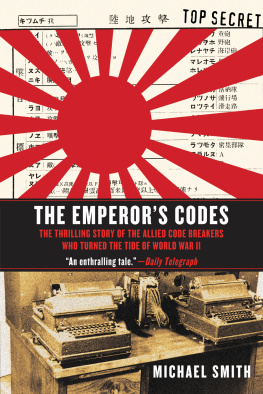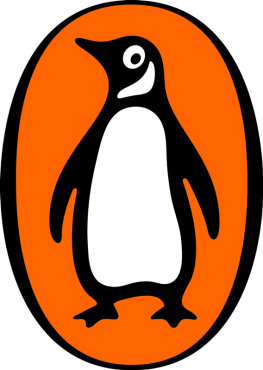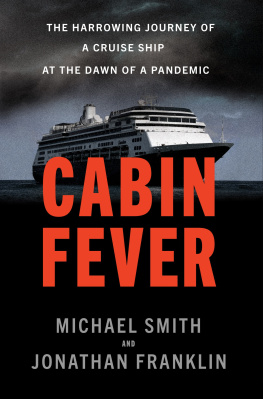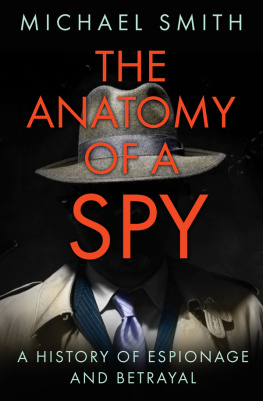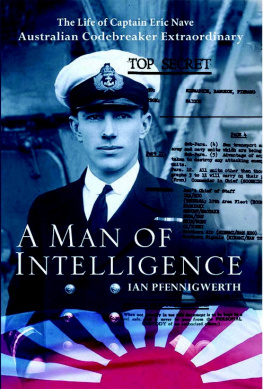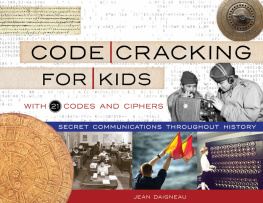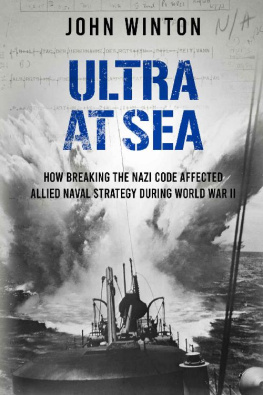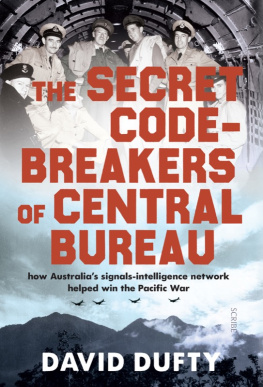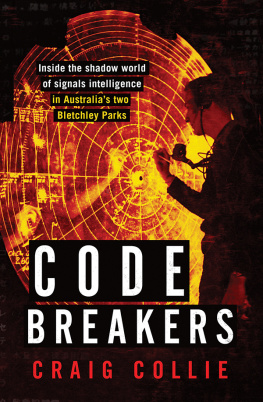THE
EMPERORS
CODES
THE
EMPERORS
CODES
THE THRILLING STORY OF THE ALLIED
CODE BREAKERS WHO TURNED
THE TIDE OF WORLD WAR II
MICHAEL SMITH

Copyright 2000, 2011 by Michael Smith
All Rights Reserved. No part of this book may be reproduced in any manner without the express written consent of the publisher, except in the case of brief excerpts in critical reviews or articles. All inquiries should be addressed to Arcade Publishing, 307 West 36th Street, 11th Floor, New York, NY 10018.
Arcade Publishing books may be purchased in bulk at special discounts for sales promotion, corporate gifts, fund-raising, or educational purposes. Special editions can also be created to specifications. For details, contact the Special Sales Department, Arcade Publishing, 307 West 36th Street, 11th Floor, New York, NY 10018 or .
Arcade Publishing is a registered trademark of Skyhorse Publishing, Inc., a Delaware corporation.
Visit our website at www.arcadepub.com.
10 9 8 7 6 5 4 3 2 1
Library of Congress Cataloging-in-Publication Data
Smith, Michael, 1952 May 1- The emperors codes: the breaking of Japans secret ciphers / Michael Smith.
p. cm.
Original edition has subtitle: Bletchley Park and the breaking of Japans secret ciphers. Originally published: London : Bantam Press, 2000.
Includes bibliographical references and index.
ISBN 978-1-61145-017-0 (pbk. : alk. paper)
1. World War, 1939-1945--Cryptography. 2. World War, 1939-1945--Electronic intelligence. 3. Great Britain. Government Communications Headquarters--History. 4. Machine ciphers. 5. Cryptography--Japan. 6. Cryptography--United States. 7. Cryptography--Great Britain. 8. ULTRA (Intelligence system) I. Title.
D810.C88S656 2011
940.548641--dc22
2011001771
Printed in the United States of America
For Ben, Kirsty, Louise, Leila and Levin
ACKNOWLEDGEMENTS
I am extremely grateful to all those former codebreakers and wireless operators who wrote to me or agreed to be interviewed for this project. Whether or not they are quoted in the book, their contributions played a major part in providing the information and encouragement I needed to complete it. I am particularly grateful to a number of people who went out of their way to help and encourage me. These include Geoff Ballard; Edith Becker; Geoff Day; Joan Dinwoodie; Joe and Barbara Eachus; Robert Hanyok; Margaret Henderson; Phil Jacobsen; Dennis Moore; Joe Richard; Harry G. Rosenbluh; Hugh Skillen; Joe Straczek; Jimmy Thirsk and Dennis Underwood. I am also grateful to Steve Kelley for sharing his expertise in Japanese machine ciphers with me and to Hilary Jarvis for her advice on the Japanese language. Special thanks are due to Hugh Melinsky; Norman Scott; Alan Stripp and Maurice Wiles for allowing me to quote from their own works and for their generous help and advice. I must also thank Ron Bonighton, Director of Australias Defence Signals Directorate, for kindly sending me a complete set of the Technical Records of the Central Bureau (a uniquely generous example of openness from a signals intelligence organization); Margaret Nave and the Australian War Memorial for allowing me to quote from Eric Naves original manuscript; the Library and Department of East Asian Studies of the University of Sheffield for permission to quote from the diaries of Malcolm Kennedy; Christine Large and the staff of the Bletchley Park Trust for their assistance and dedication to keeping the memory of the codebreakers alive; and last but certainly not least Ralph Erskine whose willingness to share his unrivalled knowledge of wartime codebreaking operations with me provided a constant lifeline.
I should also like to thank Charles Moore, Editor of the DailyTelegraph, for generously allowing me to take a sabbatical to write The Emperors Codes; Sally Gaminara, Katrina Whone, Simon Thorogood and Sheila Lee at Transworld for their painstakingly professional work on this project; my agent Robert Kirby for his constant enthusiasm; and my wife Hayley for her patience and encouragement. The Emperors Codes
I believe most experienced cryptanalysts would agree with me that cryptanalysis is much closer to art than to science, and this is what makes the personal factor so important.
John Tiltman, Chief Cryptographer at Bletchley Park 19405

INTRODUCTION
The extraordinary achievements of the British codebreakers based at Bletchley Park in cracking Nazi Germanys unbreakable Enigma cipher are now widely known. This initially oddball collection of mathematicians, classicists and musicians performed unexpected miracles in the hastily constructed huts scattered around the grounds of an ugly mock-Tudor mansion in the small Buckinghamshire market town of Bletchley. The location had been selected in part because it was just far enough outside London to escape the threat of German bombs. But perhaps more importantly, it was midway between the glittering spires of Oxford and Cambridge, from where most of the leading codebreakers had come.
The apparently amateurish nature of these early beginnings was epitomized by the actions of the codebreakers boss, Admiral Hugh Sinclair. His power over the Government Code and Cipher School, as the codebreaking operation was known, came from his role as C, the head of MI6. Perhaps surprisingly, this was in fact no secret within the limited confines of what was then described as polite society. But Sinclair was far better known among his immediate circle of friends for his reputation as a man with a taste for the high life. They christened him Quex after the title character in Arthur Pineros popular play The Gay Lord Quex, who was described as the wickedest man in London.
This passion for the high life, and the fact that he had the personal wealth to fund it, dominated Sinclairs dealings with the codebreakers an earlier headquarters had been based in the Strand in central London, apparently for no other reason than that it was close to the Savoy Grill, one of his more favoured haunts. Unable to persuade anyone in government to pay for the codebreakers new country mansion, he dipped into his own pockets to buy it, immediately moving his favourite chef from the Savoy Grill to Bletchley Park to ensure that the codebreakers were well fed.
The result was an atmosphere at the highly secret Station X not unlike that of a weekend party at an English country mansion. The initial number of codebreakers in what was known for security reasons as Captain Ridleys Shooting Party was little more than 200. They lived in hotels in the surrounding towns and all initially worked either in the mansion itself or in a neighbouring boys school that had been commandeered for the purpose. When not breaking codes, or if simply seeking somewhere to contemplate their cryptographic puzzles, the codebreakers could wander through the lawned grounds of Bletchley Park, which included a maze, a lake and a number of rose gardens.
This brief idyll was shattered in part when the chef, unable to cope with the sometimes unusual demands of the more idiosyncratic guests at Bletchley, attempted to commit suicide. But other factors were far more crucial in the transformation that was about to take place. As the Phoney War drew to a close and Hitler turned his attention to Western Europe, Britains back was very much against the wall. The need to break Enigma and to obtain a permanent source of high-grade intelligence on German movements was paramount.

